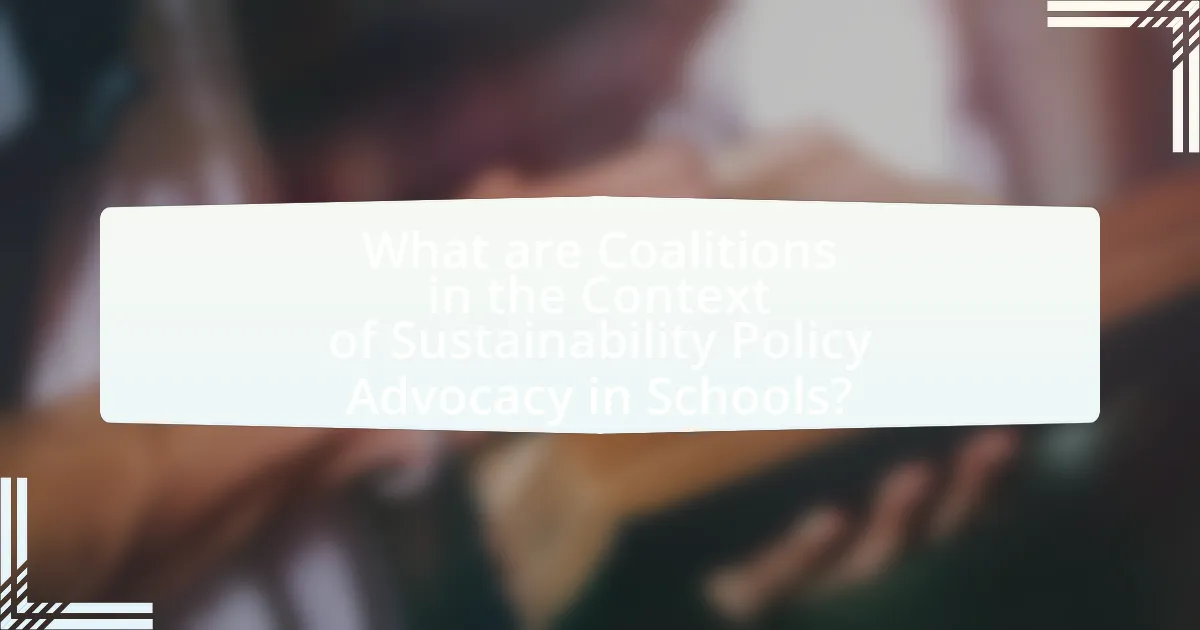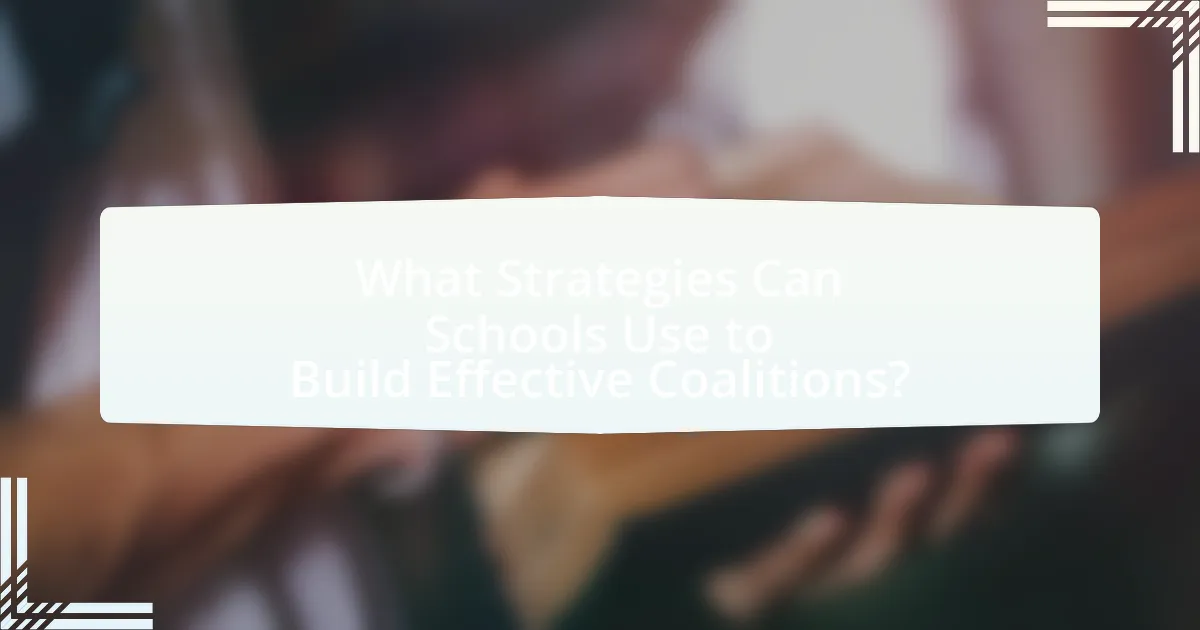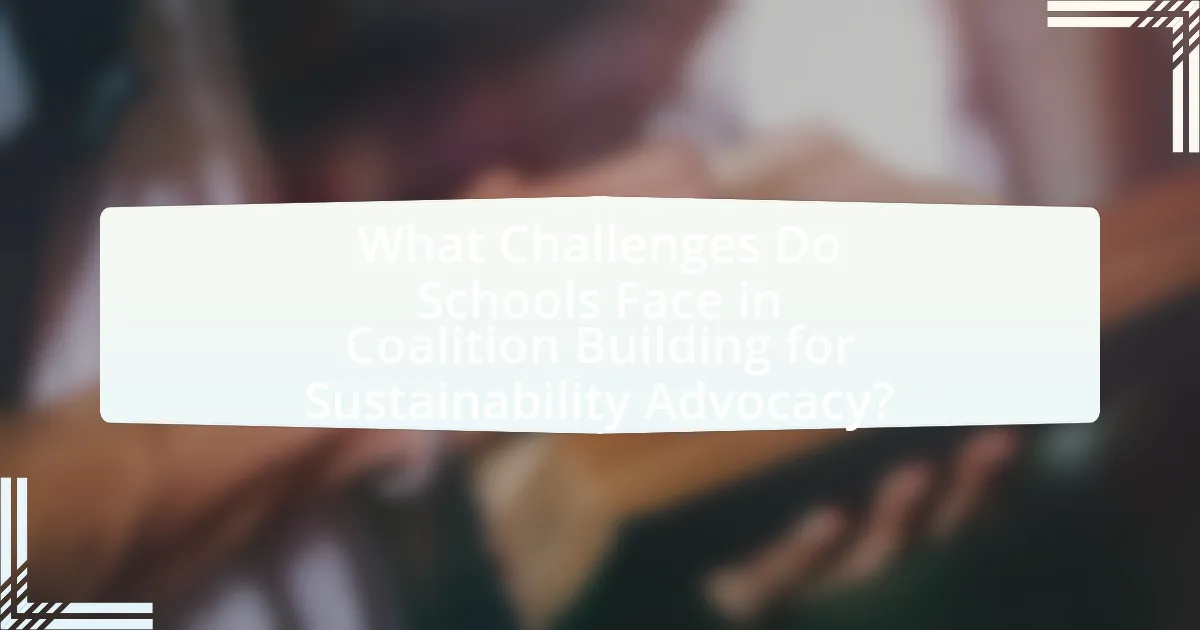The article focuses on the formation and significance of coalitions in sustainability policy advocacy within schools. It outlines how collaborative groups, consisting of educators, students, parents, and community organizations, work together to promote sustainable practices and policies. Key aspects discussed include the roles of stakeholders, strategies for building effective coalitions, methods for engaging partners, and the challenges faced in coalition-building efforts. The article emphasizes the importance of clear communication, shared goals, and inclusive participation in enhancing the effectiveness of sustainability initiatives in educational settings.

What are Coalitions in the Context of Sustainability Policy Advocacy in Schools?
Coalitions in the context of sustainability policy advocacy in schools are collaborative groups formed by various stakeholders, including educators, administrators, students, parents, and community organizations, to promote and implement sustainable practices and policies within educational institutions. These coalitions leverage diverse expertise and resources to influence decision-making processes, advocate for environmental education, and drive initiatives that align with sustainability goals. Research indicates that coalitions enhance the effectiveness of advocacy efforts by fostering shared responsibility and collective action, ultimately leading to more impactful sustainability policies in schools.
How do coalitions form around sustainability initiatives in educational settings?
Coalitions form around sustainability initiatives in educational settings through collaboration among stakeholders, including educators, students, parents, and community organizations. These stakeholders identify shared goals related to sustainability, such as reducing waste or promoting renewable energy, which fosters a sense of collective purpose. Research indicates that successful coalitions often emerge from structured frameworks that facilitate communication and resource sharing, such as the Eco-Schools program, which has engaged over 60,000 schools globally in sustainability efforts. This collaborative approach not only enhances the effectiveness of initiatives but also builds a supportive network that can advocate for policy changes at local and national levels.
What roles do stakeholders play in these coalitions?
Stakeholders in coalitions for effective sustainability policy advocacy in schools play critical roles as collaborators, decision-makers, and resource providers. Collaborators contribute diverse perspectives and expertise, enhancing the coalition’s ability to address complex sustainability challenges. Decision-makers, often representing various interests such as educators, parents, and community leaders, influence policy direction and priorities. Resource providers, including local businesses and non-profit organizations, offer financial support, materials, or services that facilitate the coalition’s initiatives. These roles are essential for fostering a comprehensive approach to sustainability in educational settings, ensuring that multiple viewpoints are considered and that resources are effectively mobilized to achieve common goals.
How can schools identify potential coalition partners?
Schools can identify potential coalition partners by assessing shared goals and values related to sustainability initiatives. This involves conducting a stakeholder analysis to pinpoint organizations, community groups, and local businesses that prioritize environmental education and sustainable practices. For instance, schools can review local environmental organizations, universities with sustainability programs, and businesses committed to corporate social responsibility. Engaging in community forums and networking events can also facilitate connections with like-minded entities. Research indicates that partnerships with organizations that have a proven track record in sustainability can enhance the effectiveness of advocacy efforts, as seen in successful coalitions formed in various educational districts across the United States.
Why are coalitions important for effective sustainability policy advocacy?
Coalitions are important for effective sustainability policy advocacy because they unite diverse stakeholders, amplifying their collective voice and influence. By bringing together various organizations, community groups, and individuals, coalitions enhance the credibility and reach of sustainability initiatives. Research shows that collaborative efforts can lead to more comprehensive policy solutions, as they incorporate multiple perspectives and expertise, which is crucial for addressing complex environmental issues. For instance, the collaboration between environmental NGOs and educational institutions has been shown to increase the effectiveness of sustainability programs in schools, leading to better resource allocation and policy implementation.
What advantages do coalitions provide over individual efforts?
Coalitions provide enhanced collective power and resource sharing compared to individual efforts. By uniting diverse stakeholders, coalitions can leverage a broader range of expertise, influence, and funding opportunities, which significantly amplifies their advocacy impact. For instance, research indicates that coalitions can achieve policy changes more effectively than individuals due to their ability to present a unified front, thereby increasing their credibility and visibility in policy discussions. Additionally, coalitions facilitate knowledge exchange and collaboration, allowing members to share best practices and strategies that can lead to more innovative and effective sustainability initiatives in schools.
How do coalitions enhance the impact of sustainability policies in schools?
Coalitions enhance the impact of sustainability policies in schools by fostering collaboration among diverse stakeholders, which amplifies resources and expertise. When schools partner with local governments, businesses, and community organizations, they can leverage shared knowledge and funding to implement more effective sustainability initiatives. For instance, a study by the National Wildlife Federation found that schools involved in coalitions reported a 30% increase in the implementation of sustainability practices compared to those acting independently. This collaborative approach not only increases the reach and effectiveness of sustainability policies but also builds a supportive community that encourages ongoing commitment to environmental education and practices.

What Strategies Can Schools Use to Build Effective Coalitions?
Schools can build effective coalitions by fostering collaboration among diverse stakeholders, including teachers, parents, students, and community organizations. Establishing clear communication channels and shared goals is essential for aligning interests and enhancing commitment. Research indicates that coalitions with defined roles and responsibilities are more successful; for instance, the National Network of Partnership Schools emphasizes the importance of structured partnerships to achieve common objectives. Additionally, regular meetings and feedback mechanisms can strengthen relationships and ensure ongoing engagement, as evidenced by successful initiatives documented in the Coalition for Community Schools’ reports.
What steps should schools take to initiate coalition-building?
Schools should begin coalition-building by identifying key stakeholders, including teachers, parents, community organizations, and local businesses. Engaging these stakeholders through initial meetings fosters collaboration and establishes a shared vision for sustainability initiatives. Research indicates that inclusive participation enhances the effectiveness of coalition efforts, as seen in the “Coalition Building for Sustainability” study by the University of California, which highlights that diverse perspectives lead to more comprehensive solutions. Following stakeholder engagement, schools should develop a clear action plan that outlines goals, roles, and responsibilities, ensuring all parties understand their contributions to the coalition’s objectives. This structured approach not only promotes accountability but also strengthens the coalition’s foundation for long-term sustainability advocacy.
How can schools effectively communicate their sustainability goals to potential partners?
Schools can effectively communicate their sustainability goals to potential partners by utilizing clear, concise messaging that highlights specific objectives and measurable outcomes. For instance, schools should present data on energy savings, waste reduction, or carbon footprint decreases achieved through existing initiatives, which can demonstrate the impact of their sustainability efforts. Additionally, engaging storytelling that includes testimonials from students and faculty can personalize the goals and make them relatable. Research indicates that partnerships are more likely to form when schools articulate their sustainability vision in alignment with the values and interests of potential partners, such as local businesses or environmental organizations. By providing concrete examples of past successes and outlining future plans, schools can foster trust and encourage collaboration.
What methods can be used to engage stakeholders in the coalition-building process?
To engage stakeholders in the coalition-building process, methods such as inclusive dialogue, collaborative workshops, and stakeholder mapping can be employed. Inclusive dialogue fosters open communication, allowing stakeholders to express their concerns and ideas, which builds trust and commitment. Collaborative workshops facilitate joint problem-solving and brainstorming, enabling stakeholders to co-create solutions that reflect diverse perspectives. Stakeholder mapping identifies key individuals and groups, ensuring that all relevant voices are considered and engaged throughout the process. These methods are effective as they promote participation, enhance relationships, and ensure that the coalition reflects the interests of all stakeholders involved.
How can schools maintain and strengthen coalitions over time?
Schools can maintain and strengthen coalitions over time by fostering continuous communication and collaboration among stakeholders. Regular meetings, updates, and shared goals ensure that all parties remain engaged and aligned with the coalition’s mission. Research indicates that coalitions with structured communication strategies, such as the use of collaborative platforms and scheduled check-ins, report higher levels of member satisfaction and commitment. For instance, a study by the Community Tool Box highlights that effective coalitions often utilize feedback mechanisms to adapt and evolve their strategies, thereby enhancing their longevity and impact.
What practices foster collaboration and trust among coalition members?
Practices that foster collaboration and trust among coalition members include open communication, shared goals, and mutual respect. Open communication ensures that all members feel heard and valued, which builds a foundation of trust. Establishing shared goals aligns the coalition’s efforts and encourages teamwork, as members work towards a common purpose. Mutual respect among members acknowledges diverse perspectives and expertise, fostering an inclusive environment that enhances collaboration. Research indicates that coalitions with these practices are more effective in achieving their objectives, as they create a supportive atmosphere that encourages active participation and commitment.
How can schools measure the effectiveness of their coalitions?
Schools can measure the effectiveness of their coalitions by evaluating specific outcomes such as improved student engagement, enhanced community partnerships, and successful implementation of sustainability initiatives. These outcomes can be assessed through surveys, feedback from stakeholders, and tracking the progress of coalition-driven projects. For instance, a study by the National School Boards Association found that schools with active coalitions reported a 30% increase in student participation in sustainability programs, indicating a direct correlation between coalition effectiveness and student involvement. Additionally, analyzing the impact of coalition activities on school policies and practices provides concrete evidence of their effectiveness in advocating for sustainability.

What Challenges Do Schools Face in Coalition Building for Sustainability Advocacy?
Schools face several challenges in coalition building for sustainability advocacy, primarily including limited resources, lack of stakeholder engagement, and differing priorities among community members. Limited resources, such as funding and personnel, hinder the ability to mobilize and sustain coalitions effectively. Additionally, engaging diverse stakeholders—such as parents, local businesses, and government entities—can be difficult due to varying levels of interest and commitment to sustainability initiatives. Differing priorities among these stakeholders often lead to conflicts, making it challenging to establish a unified vision for sustainability advocacy. These factors collectively impede the formation of effective coalitions necessary for driving meaningful sustainability policies in educational settings.
What common obstacles hinder the formation of coalitions?
Common obstacles that hinder the formation of coalitions include differing priorities among stakeholders, lack of trust, and insufficient resources. Differing priorities can lead to conflicts in objectives, making it challenging for groups to align their goals. Lack of trust among potential coalition members can prevent open communication and collaboration, which are essential for effective coalition-building. Insufficient resources, such as funding or personnel, can limit the ability of groups to engage in coalition activities and sustain their efforts over time. These factors collectively impede the establishment of effective coalitions necessary for advocating sustainability policies in schools.
How can schools address issues of conflicting interests among stakeholders?
Schools can address issues of conflicting interests among stakeholders by implementing structured communication and collaborative decision-making processes. Establishing regular forums for dialogue allows stakeholders, including parents, teachers, administrators, and community members, to express their concerns and perspectives. Research indicates that schools that engage stakeholders through inclusive practices, such as advisory committees or focus groups, can better align their goals and policies with the diverse interests present. For instance, a study by the National School Boards Association found that schools with strong stakeholder engagement reported higher satisfaction and fewer conflicts, demonstrating the effectiveness of these collaborative approaches in resolving conflicting interests.
What strategies can mitigate resource limitations in coalition efforts?
Collaborative resource sharing is a key strategy to mitigate resource limitations in coalition efforts. By pooling resources such as funding, expertise, and materials, coalition members can enhance their collective capacity to advocate for sustainability policies in schools. For instance, research by the National Coalition for Dialogue & Deliberation highlights that coalitions that share resources can achieve greater impact and efficiency, as evidenced by successful initiatives that leveraged combined funding to implement sustainability programs in educational settings. Additionally, establishing partnerships with local businesses and organizations can provide access to additional resources and support, further strengthening coalition efforts.
How can schools overcome resistance to sustainability initiatives within coalitions?
Schools can overcome resistance to sustainability initiatives within coalitions by fostering open communication and collaboration among stakeholders. Engaging all members in discussions about the benefits and importance of sustainability can help address concerns and misconceptions. Research indicates that when stakeholders feel heard and valued, their resistance decreases; for instance, a study by the National Education Association found that inclusive decision-making processes lead to higher buy-in for sustainability efforts. Additionally, providing education and training on sustainability practices can empower coalition members, making them more likely to support initiatives.
What approaches can be taken to educate and inform skeptics?
To educate and inform skeptics, engaging them through evidence-based discussions and interactive learning experiences is essential. Utilizing data from credible sources, such as scientific studies and expert testimonials, can effectively address misconceptions. For instance, research by the National Academy of Sciences highlights the importance of presenting clear, factual information about climate change impacts, which can help shift skeptical views. Additionally, incorporating hands-on activities, such as workshops or simulations, allows skeptics to experience the relevance of sustainability firsthand, fostering a deeper understanding and acceptance of the subject.
How can schools leverage success stories to gain support for sustainability policies?
Schools can leverage success stories to gain support for sustainability policies by showcasing tangible outcomes from previous initiatives. Highlighting successful projects, such as energy-efficient upgrades or waste reduction programs, demonstrates the effectiveness of sustainability efforts and their positive impact on the school community. For instance, a school that reduced its energy consumption by 30% through solar panel installation can use this achievement to illustrate potential cost savings and environmental benefits. This evidence-based approach not only builds credibility but also inspires stakeholders, including parents, local businesses, and policymakers, to support further sustainability initiatives.
What Best Practices Should Schools Follow for Successful Coalition Building?
Schools should prioritize clear communication, shared goals, and inclusive participation for successful coalition building. Clear communication ensures that all stakeholders understand the coalition’s purpose and objectives, fostering trust and collaboration. Establishing shared goals aligns the interests of diverse groups, making it easier to work together towards common outcomes. Inclusive participation invites input from all relevant parties, including students, parents, and community members, which enhances the coalition’s effectiveness and sustainability. Research indicates that coalitions with diverse representation are more likely to achieve their objectives, as they can leverage a wider range of resources and perspectives.
How can schools create a clear vision and mission for their coalitions?
Schools can create a clear vision and mission for their coalitions by engaging stakeholders in a collaborative process that defines shared goals and values. This involves organizing workshops or meetings with teachers, students, parents, and community members to gather input and foster a sense of ownership. Research indicates that inclusive decision-making enhances commitment and clarity, as seen in the Coalition for Community Schools model, which emphasizes stakeholder engagement in developing a unified vision. By articulating specific objectives and aligning them with the broader goals of sustainability policy advocacy, schools can ensure that their coalitions operate with a focused and cohesive mission.
What role does ongoing communication play in coalition success?
Ongoing communication is essential for coalition success as it fosters trust, alignment, and collaboration among members. Effective communication ensures that all stakeholders are informed about goals, progress, and challenges, which enhances collective decision-making and problem-solving. Research indicates that coalitions with strong communication practices are more likely to achieve their objectives, as evidenced by a study published in the “American Journal of Community Psychology,” which found that coalitions with regular communication meetings reported higher levels of member engagement and satisfaction. This demonstrates that ongoing communication is a critical factor in maintaining a cohesive and effective coalition focused on sustainability policy advocacy in schools.

Leave a Reply